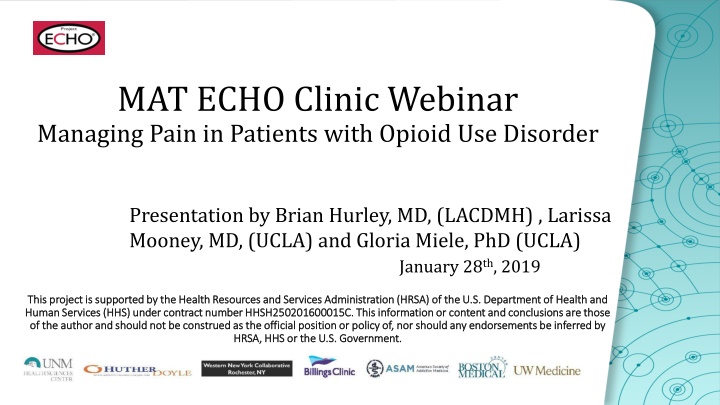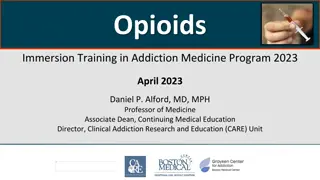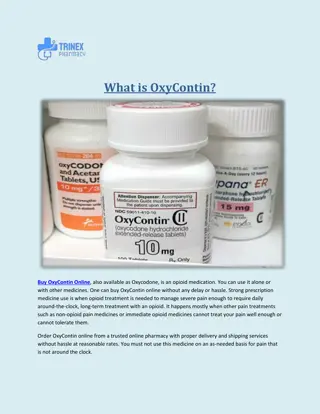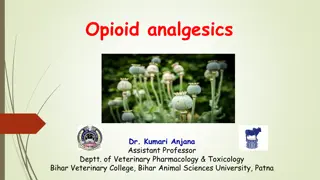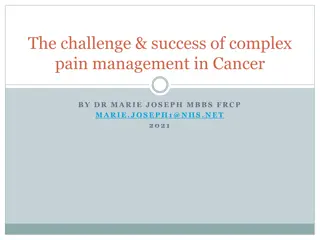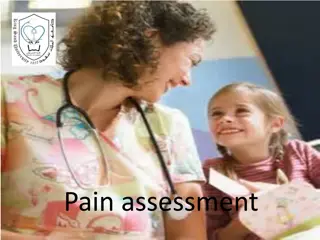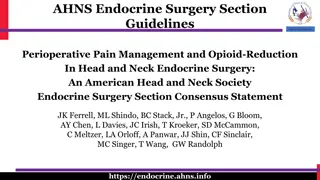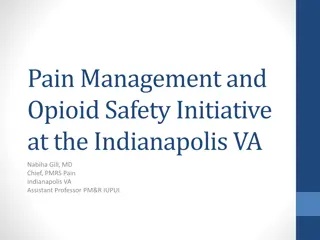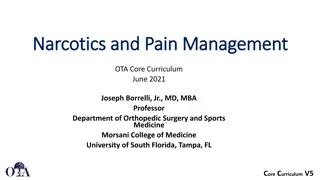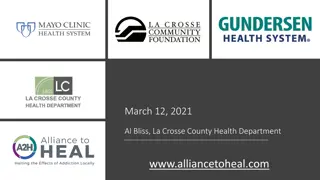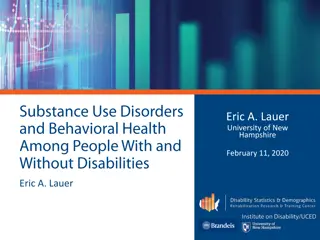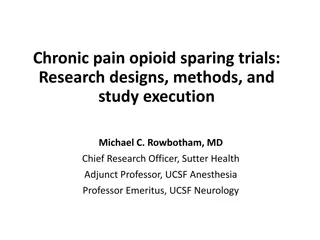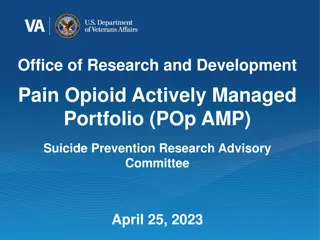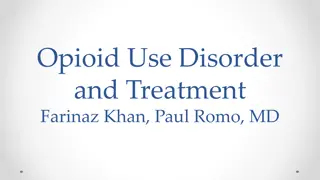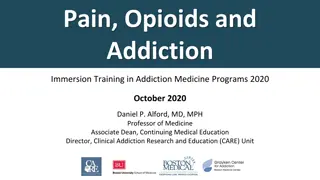Managing Pain in Patients with Opioid Use Disorder: Strategies and Approaches
This presentation discusses essential factors to consider when treating pain in patients with Substance Use Disorder (SUD), including approaches for acute pain in those on Medication-Assisted Treatment (MAT) and non-opioid therapies for chronic pain. The information covers altered pain experiences in opioid-dependent individuals, pain treatment strategies in patients with SUD, and objectives for healthcare providers to enhance patient care and outcomes.
Download Presentation

Please find below an Image/Link to download the presentation.
The content on the website is provided AS IS for your information and personal use only. It may not be sold, licensed, or shared on other websites without obtaining consent from the author.If you encounter any issues during the download, it is possible that the publisher has removed the file from their server.
You are allowed to download the files provided on this website for personal or commercial use, subject to the condition that they are used lawfully. All files are the property of their respective owners.
The content on the website is provided AS IS for your information and personal use only. It may not be sold, licensed, or shared on other websites without obtaining consent from the author.
E N D
Presentation Transcript
MAT ECHO Clinic Webinar Managing Pain in Patients with Opioid Use Disorder Presentation by Brian Hurley, MD, (LACDMH) , Larissa Mooney, MD, (UCLA) and Gloria Miele, PhD (UCLA) January 28th, 2019 This project is supported by the Health Resources and Services Administration (HRSA) of the U.S. Department of Health and This project is supported by the Health Resources and Services Administration (HRSA) of the U.S. Department of Health and Human Services (HHS) under contract number HHSH250201600015C. This information or content and conclusions are those Human Services (HHS) under contract number HHSH250201600015C. This information or content and conclusions are those of the author and should not be construed as the official position or policy of, nor should any endorsements be inferred by of the author and should not be construed as the official position or policy of, nor should any endorsements be inferred by HRSA, HHS or the U.S. Government. HRSA, HHS or the U.S. Government.
Managing Pain in Patients with Opioid Use Disorder Developer: Stephen A. Wyatt, DO Medical Director, Addiction Medicine Carolinas HealthCare System Reviewer/Editor: Miriam Komaromy, MD, The ECHO Institute Presenter: Brian Hurley, MD, UCLA bhurley@ucla.edu
Disclosures The speakers do not have relevant financial relationships with commercial interests.
Objectives By the end of this ECHO, providers and primary care teams will be able to: Indicate three (3) factors to consider when treating pain in patients with SUD. Identify two (2) approaches to treating acute pain in patients on medication-assisted treatment (MAT). Specify three (3) non-opioid therapies for chronic pain. Summarize two (2) lessons learned from case discussion.
Altered Pain Experience Opioid Dependent Patients Less pain tolerance when opioid dependent Less pain tolerance on agonist maintenance. Less pain tolerance in women on methadone maintenance after cesarean delivery Martin J (1965), Compton P (2000), Meyer M (2007)
Pain Treatment in Patients with SUD Explain potential for relapse Explain the rationale for the medication management to patient and supports Establish a treatment plan with the patient Encourage family/support system involvement Frequent follow-ups Consultations and multidisciplinary approach
Cycle of Uncontrolled Pain Avoidance Behaviors Decreased Mobility Pain Altered Functional Status Social Limitations Diminished Self- Efficacy
Perceived Pain as Suffering At risk patients Past history of substance use disorder Emotionally traumatized Dysfunctional / alcoholic family Lacks effective coping skills Dependent traits Paul Farnum, MD PHP, BC
Chronic Pain Has Many Drivers Patient A Pain 8/10 Patient B Pain 8/10 Cultural Background Cultural BackgroundEnvironmental Environmental Stressors Stressors Functional Disability Genetics Functional Disability Physical Injury Genetics Physical Injury Cognitive Dysfunction Social Disability Cognitive Dysfunction Social Disability Addiction Depression & Anxiety Depression & Anxiety Gatchel RJ. Am Psychol. 2004
Alternative Therapies for Chronic Pain Psychological Interventions Mindfulness therapy Cognitive therapy Monitor thoughts and feelings Attention diversion and distraction Imagery and Hypnosis Behavioral therapy Activity monitoring Stress monitoring and reduction Relaxation and Biofeedback Communication Skills, e.g. assertiveness training Goal setting, monitor progress
Non-Opioid Alternatives to Pain Management Medications NSAIDS Anticonvulsants Antidepressants (SNRIs, SSRIs, TCAs) Topical agents Non-Pharmacologic Exercise Manual therapies Acupuncture Orthotics TENS Interventions Nerve blocks Steroid injections Trigger point injections Stimulators
Treatment of Acute Pain During Agonist Treatment Maintain current dose of the agonist treatment Methadone and buprenorphine analgesic properties are shorter acting than their potential to reduce craving and withdrawal so divided doses are more effective. Opioid analgesic doses will typically be higher due to cross tolerance and increased pain sensitivity Risk of relapse may be higher with inadequate pain management Avoid using mixed agonist/antagonist meds (e.g. butorphanol) Alford DP, et.al. Ann Internal Med 2006
Acute Pain in the Methadone Tx Patient Continue once daily methadone dose Add full agonist for acute pain and post-op Patients on agonist therapy will have a higher tolerance Continue to monitor the patient when titrating and tapering the opioid Alford DP, Compton P, Samet JH. Ann Intern Med 2006 Kantor TG et al. Drug and Alc Dependence. 1980
Methadone Maintenance and Chronic Pain Determining Opioid Effect on Pain: Opioid Responsive Pain: Following the administration of methadone there is pain relief then 6-8 hrs. later pain returns. Pain Due to Opioid Withdrawal: Pain returns >24hr after administration of methadone Note: Methadone typically blocks the euphoric effects of other opioids.
Problems associated with Pain Management in MMT Patients Methadone clinics cannot administer methadone three or four times a day Methadone can only be prescribed for opioid use disorder in an OTP Drug testing more confusing if an additional opioid is being prescribed Focus on non-medication and non-opioid medication treatments for pain
Buprenorphine for Pain Sublingual combination, buprenorphine/naloxone and generic mono-products are only approved for treatment of opioid use disorders It can be used off label for pain The parenteral and transdermal forms are not approved for treatment of OUD It is illegal to use these formulations for the treatment of an OUD
Buprenorphine Safety and Pain An increase in the dose can improve analgesia but there is no change in respiratory depression. Dahan A et al. Br J Anaesh 2006
Acute Pain in the Buprenorphine Maintained Patient Attempt stabilization with non pharmaceutical and non- opioid treatments Consider splitting buprenorphine dose Consider temporary dose increase If full agonist needed, use a full agonist with buprenorphine. In rare cases is it appropriate to discontinue buprenorphine and initiate a full agonist
Perisurgical Pain Management For major surgical procedures: Recent data suggest that buprenorphine can be continued throughout surgical course, and full opioid agonists can be added for additional pain control Historically the guidance had been: Take the last dose the day before surgery. Restart buprenorphine when pain is stabilized. Continue opioid supplementation either parenteral or oral if necessary (Kornfeld, Am J Ther, 2010, Oifa, Clin Ther, 2009)
SL Buprenorphine: Pain Dosage OFF LABEL Opioid Naive 1-2 mg BID- QID (3-6mg/day) Opioid Tolerant 4mg TID-QID (12-16mg/day) 24mg/day split upper limits 32mg/day maximum split dose
Chronic Pain Not Associated with Worse MAT Outcomes Prospective study: Comparing Office-based opioid treatment (OBOT) retention and opioid use patients with and without pain Results: no association between pain and buprenorphine treatment outcomes Fox AD et al. Subst Abus. 2012;33(4):361-5 Meta-Analysis review: Chronic non-cancer pain may increase the risk for poor physical, psychiatric, as well as personal and social functioning for patients with opioid use disorder and on MMT Dennis BB, et.al., Subst Abuse. 2015; 9: 59 80
Naltrexone Long Acting Injection: Mild to Moderate Acute Pain Nonpharmacologic Therapies: Stress management/CBT Exercise Physical therapy/Osteopathic Manipulative Treatment Peripheral nerve block Centroneuraxial block Local anesthetic infiltration Non Opioid Therapies: Acetaminophen NSAIDs NMDA antagonists (ex. Ketamine) Alpha-2 agonists (ex. Clonidine) Antispasmotics (ex. Baclofen) Antineuropathic agents (ex. Gabapentin)
Naltrexone Long Acting Injection: Severe Acute Pain Naltrexone will block full opioid agonists Optimize all non-opioid and non-medication treatment modalities for moderate pain May require high dose full opioid infusion in the ICU setting As naltrexone effect wanes, full agonist dosing must be closely monitored to avoid overdose
Naltrexone Patient: Elective Surgery Oral naltrexone: (1/2 life 14hrs X 5 lives) discontinue 72 hours prior to surgery Naltrexone Long Acting Injection: at 25 days there is a 98% elimination of the drug typically recommend waiting an additional 3 days one can discontinue the injectable form at the normal 4 week interval and then initiate oral naltrexone and discontinue oral naltrexone 72 hours prior to surgery Robers LJ. Aust Presc 2008; 31:133 Vickers, AP and A Jolly. British Medical Journal 2006 Jan 21;332(7534):132-3 Arnold R, Childers J, UpToDate, Waltham, MA, Dec. 13, 2014
Summary Opioid Use Disorder complicates the management of acute and chronic pain Best to maintain agonist or antagonist OUD medication while being treated for concurrent pain Strongly recommend multi-disciplinary treatment in managing these complex patients
Thank you! Questions? Brian Hurley, MD - BHurley@ucla.edu Larissa Mooney, MD - LMooney@mednet.ucla.edu Gloria Miele, PhD Gmiele@mednet.ucla.edu
